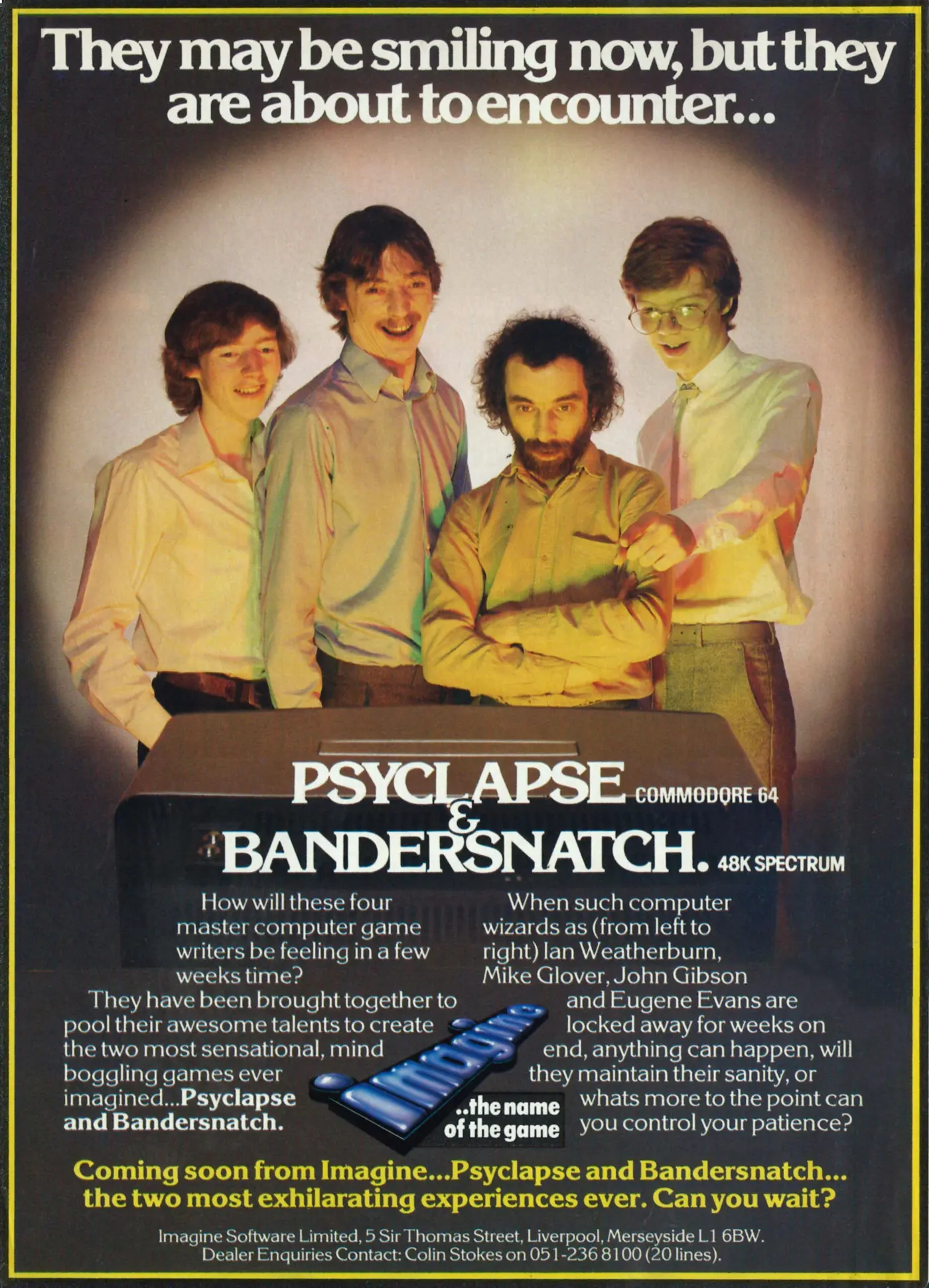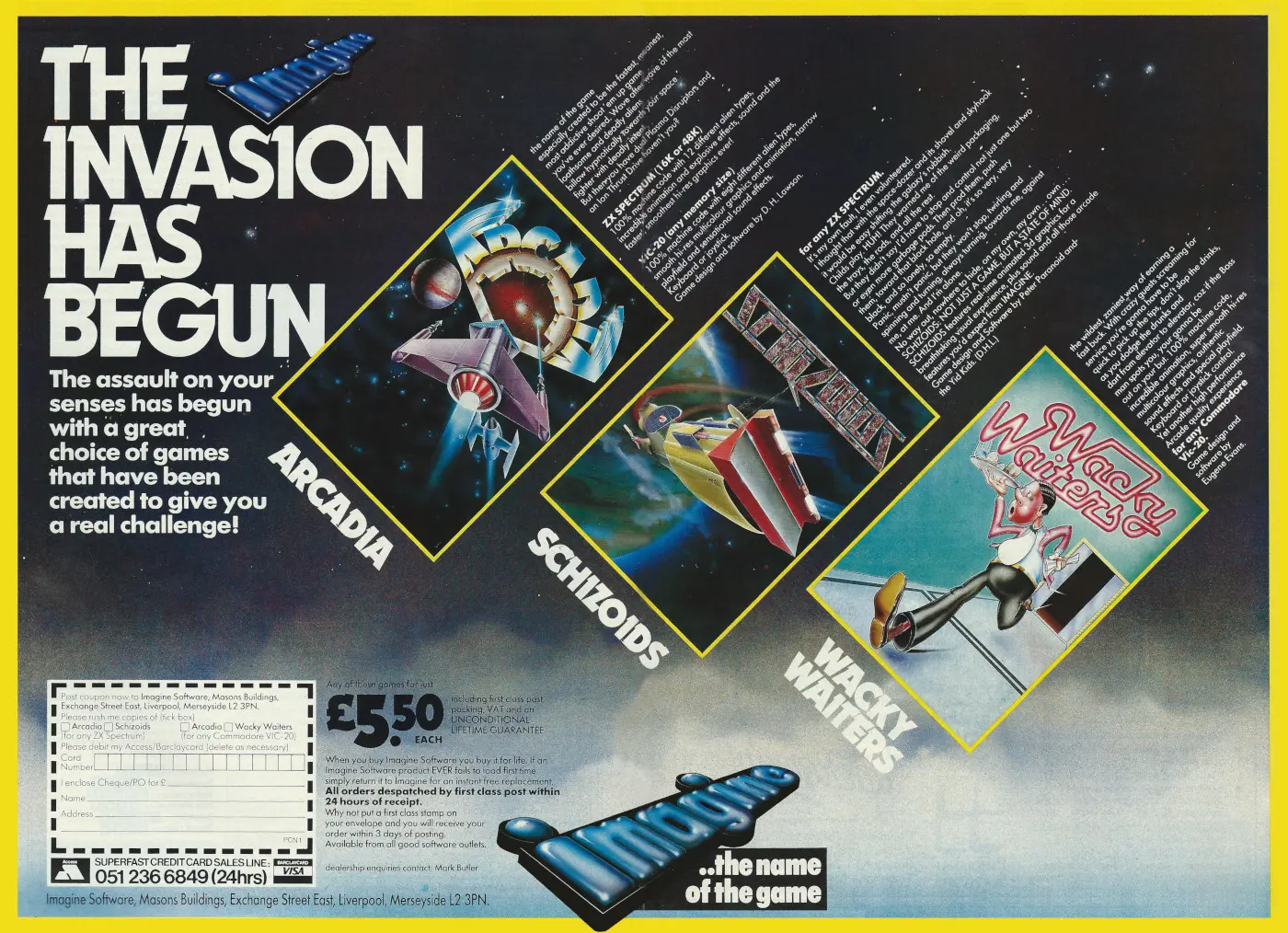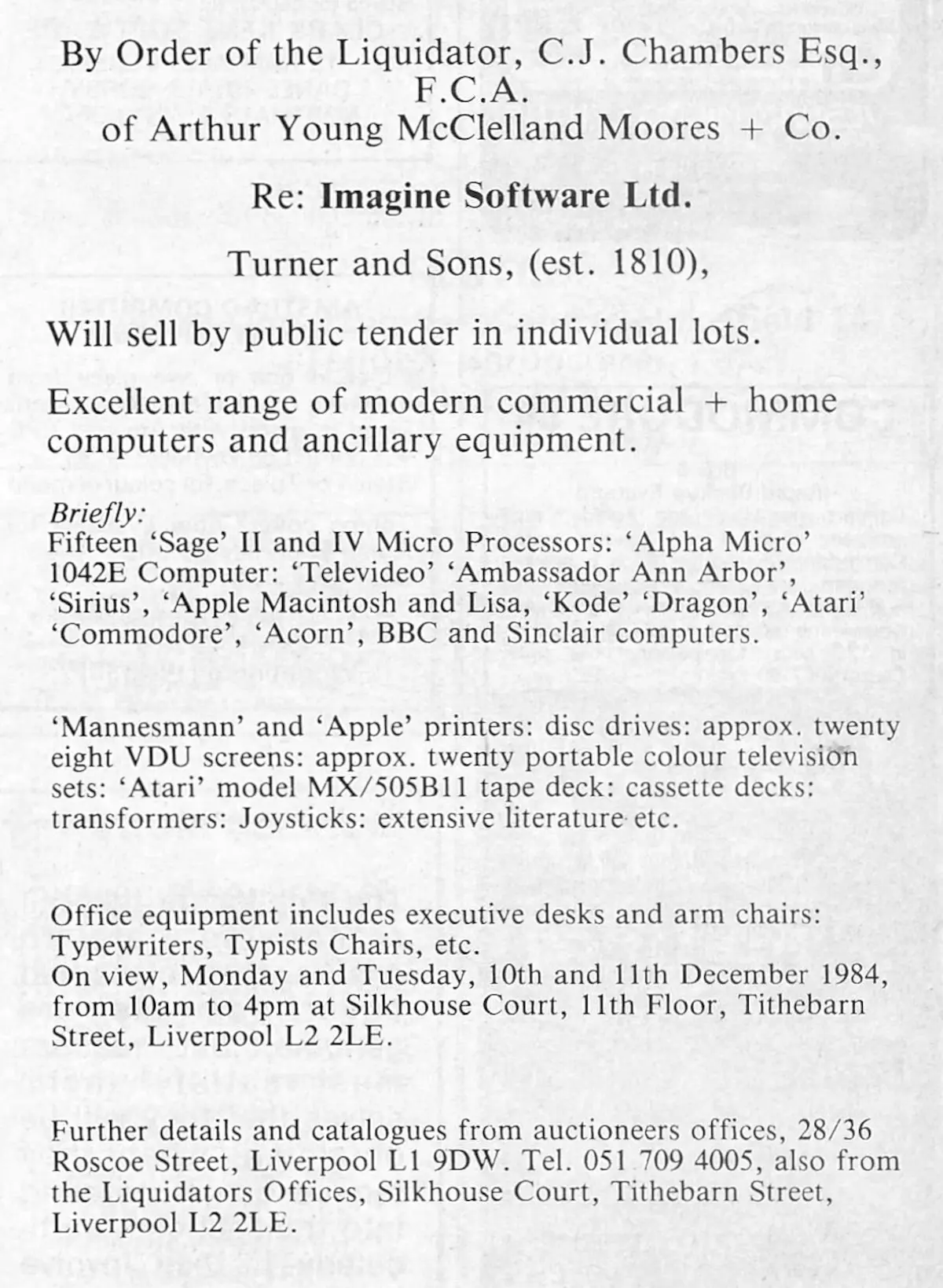Imagine Advert - February 1984
From Your Computer

They may be smiling now, but they are about to encounter... Psyclapse and Bandersnatch
Imagine had formed when programming wunderkind Eugene Evans and two other senior staff left well-known software house Bug-Byte, which had been famous for Commodore and Sinclair games.
The company expanded rapidly, and at one point placed an advert for "situations available" in March 1984's Micro User with no fewer than 56 roles, including 30 for programmers. Perks included above-average salaries and "in many cases, a new car and numerous fringe benefits".
Claiming that it was already the largest and most successful game software house outside of the US, it already had more than 100 staff occupying its 19,000ft² of office space around Liverpool.
Imagine would later became notorious for its excesses when it was filmed - going bust - for a BBC documentary, as well as for its 20-something millionaires.
It was also well known for lavish advertising, which was to largely prove its downfall.

Early Imagine advert for its Spectrum and VIC-20 games Arcadia, Schizoids and Wacky Waiters, © Personal Computer News April 1983
After its advertising agency Studio Sting - run by Imagine shareholder Stephen Blower - went bust with debts of £50,000, Imagine continued to book adverts itself but didn't get round to actually paying for them, with the final trigger for collapse coming when publishing company VNU sued it for unpaid advertising bills[1].
It had also racked up debts with tape duplicators and it was also having to pay back a rumoured £500,000 to Marshall Cavendish following an embarassing cancellation of a major software project for Cavendish's new "Input" magazine-based computer course, over a "difference of opinion", according to Imagine's general manager Bruce Everiss.

Notice of the auction of the remains of Imagine Software by its liquidator, C. J. Chambers of Arthur Young McClelland Moores and Company. From Your Computer, December 1984
After the collapse, which happened in July 1984, Everiss was faced with the unenviable task of finding jobs for the 60 staff left after Butler, Lawson and Heatherington had legged it.
Talking to CRASH magazine, Everiss said
"it makes me sick to think that the people who have worked so hard to make the wealth of Imagine have been left high and dry while the directors of the company have stripped it bare and got away scot free. They did everything to line their own pockets".
Not content with all of that, Imagine had also had to reduce the retail price of its games in order to help shift excess stock[2] - the company was one of many software houses dealing with a glut following poor sales over Christmas 1983.
Sinclair had tried, at least briefly, to fix the lack of games for its ill-fated QL machine by buying up the Bandersnatch "megagame" from the remains of Imagine Software.
After the Sinclair aquisition of Bandersnatch, which was confirmed during October 1984, several ex-Imagine staff - including former directors Dave Lawson and Ian Hetherington, as well as Evans, Tom Flannery, Michael Glover and Andrew Sinclair - set up new company Fire Iron in Liverpool to develop it and the various other Megagames on behalf of Sinclair.
Lawson reported "At Imagine we were working on seven megagame titles. I see no reason why we shouldn't continue with them all".
Following the deal - which incidentally required that all royalties from Bandersnatch and the others would go to Imagine's creditors via the liquidators - the original targets of the Spectrum and Commodore 64 were dropped and the game was completely re-written for the QL.
However it was not as a ROM cartridge as had been originally planned[3], most likely because the QL could now only support 16K ROMs anyway following the "fix" for the overflowing-operating-system issue.
The royalties from Bandersnatch and the others had to go to Imagine's creditors via the liquidators, because Imagine had illegally sold the rights to its games to London software house Beau Jolly whilst insolvent, which left the creditors with no assets to sell when it crashed[4].
By the early spring of 1985, Fire Iron had a new backer in the form of Liverpool businessman and millionaire Talbot Smith, who Everiss joked had "threatened to break [his] knees" after one of the practical jokes which apparently plagued Fire Iron had gone a bit too far.
Word was that in one week, six driving schools had turned up to give a first driving lesson to Eugene Evans - who had once owned a Lotus during his Imagine years - and Everiss was prime suspect. "Talbot Smith's gopher" had warned about the high-jinks, which Everiss followed up by sending over a bunch of daffodils, a move which promted the alleged knee-related threat[5].
Smith had met Lawson by accident after Lawson's house - which used to be owned by Smith - was being burgled, and Smith - who by now had moved next door, came round to help with the burglar alarms, and even chase away the intruders.
The two got socialising, and Lawson apparently convinced Smith that "the Megagame was too good to lose"[6].
Some time around April 1985, following disagreements and the fact that the game still wasn't ready, Sinclair stopped its funding and the game - along with the QL - were both abandoned, with Talbot Smith saying:
"We decided to upgrade the game and put it on the Atari ST"
Bandersnatch eventually re-surfaced for the ST as the game Brataccas, produced by Psygnosis, which formed out of Fire Iron when the original game was dropped[7].
There seemed to be some sort of turmoil at Psygnosis, so Atari hadn't yet published the game and was said to waiting for Psygnosis to "sort itself out". Talbot Smith was keen to get the rights back so the game could be ported to other machines, saying:
"there are three games, starting with Brattacas, and we want to sell the rights on Macintosh, Atari ST and Amiga, so that makes nine packages, for which we'd expect around £500,000 (£1,895,900 in 2025)".
Eugene Evans was once said to have been "the most brilliant programmer of [the] age" when writing games for the VIC-20, however he didn't seem to make the shift to the 68000 - as used on the QL, Atari ST, et al - particularly well.
Bruce Everiss, who had frequently made the genius claim when Evans and he were at Imagine, even said "he can't program", whilst Talbot Smith suggested that Evans was now effectively his Personal Assistant, saying:
"He finds things out for me, he trains me in these computers. When I want to know about disk formats, he finds out".
It was a bit of a fall from grace after having been invited to Number 10 Downing Street by Margaret Thatcher, appearing on TV program "Tell The Truth" and generally being famous.
Guy Kewney, writing in January 1986's Personal Computer World said of the situation that:
"It's a bit like turning a corner and meeting a couple of derelict alcoholics in the gutter, and finding one is Michael Parkinson, and the other Geoffrey Boycott. I don't think I was meant for this kind of stress"[8].
Date created: 10 February 2024
Last updated: 11 December 2024
Hint: use left and right cursor keys to navigate between adverts.
Sources
Text and otherwise-uncredited photos © nosher.net 2025. Dollar/GBP conversions, where used, assume $1.50 to £1. "Now" prices are calculated dynamically using average RPI per year.